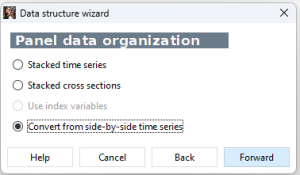Blog
New features, fixed bugs, and software news are shown here
A good concise list is provided in the official changelog, here the aim is to be more explicit and sometimes give some examples. Before the respective new gretl version is released, the examples will only work in snapshots that are recent enough, or with self-compiled bleeding-edge versions.
New in gretl 2024b
gridplot title
You can add a title to a gridplot now.
open bikesharing
gpbuild bikers
gnuplot temp --time-series
gnuplot casual --time-series
end gpbuild
gridplot bikers --title="Cool bikers" --output=display
Dynamic scaling of fonts in many gretl windows
You can enlarge or shrink the font size very much like in a web browser, for example using ctrl_+ or ctrl_- keys.
Gamma distribution in distribution plotting tools
The distribution plotting tool (under the Tools menu) now also supports the Gamma distribution.
Panel dataset subsampling
If you're subsampling a panel dataset with the graphical dialogs, telling gretl to maintain the panel structure is now easier.
New in gretl 2024a
(as always, just a selection)
more flexible info command
Not a huge new feature, but the info command now offers a scripting way to editing the meta data of a dataset. The GUI analog (which has always been possible) is to go to Data / Dataset info.
The relevant new options are --to-file and --from-file.
matrix and time-series in gnuplot command
gnuplot command with --matrix and --time-series options show dataset time on x-axis if possible.
open denmark
m = {LRM}
gnuplot --matrix=m --time-series --with-lines --output=display
And also related to time series plots with matrices, you can now do:
open denmark
m = {dataset}
tsplots --matrix=m --output=display
New in gretl 2023c
(this is just a selection, not exhaustive)
gridplot command
This new native command makes it possible to arrange several subplots in a grid (rectangular) layout. As such it will pretty much replace the contributed function package multiplot. There are basically two ways of using it:
First, using some other plotting commands, redirect the output to a string buffer inside a strings array. Then execute the gridplot command on that array. Example:
open australia strings temparr = array(2) qqplot IAU --outbuf=temparr[1] kdplot E --outbuf=temparr[2] gridplot temparr --output=display
Secondly, use the companion command gpbuild in a block format, and then define the individual parts:
open data4-10
gpbuild MyPlots
gnuplot ENROLL CATHOL
gnuplot ENROLL INCOME
gnuplot ENROLL COLLEGE
end gpbuild
gridplot MyPlots --output=display
tsplots (virtual) command
You can now use the new tsplots command to create several joint time-series plots easily. Example:
open denmark tsplots LRM LRY --output=display
This has actually "always" been possible with the scatters command --and was duly documented-- but it was somewhat counterintuitive to use a command for scatter plots to draw time-series lines.
plot multiple bands
Plotting a single band to represent a confidence area or something similar has been possible for a long long time. Now you can also insert more than one band into a plot. The syntax relies on specifying a hansl bundle for each band and then passing all of them inside an array of bundles to the gnuplot call. Meaningless example:
# create artificial data nulldata 50 setobs 1 1 --time-series series y = log(time) # main line to be plotted series w = normal() # example width series series x1 = y + 0.1 # optional center different from y series x2 = y - 0.1 # ditto # specify the band specs bundle b1 = _(center="x1", width="w", style="bars") bundle b2 = _(center="x2", width="w", factor=0.2, style="fill", color="grey") bundles bandspecs = defarray(b1,b2) # execute the plot gnuplot y --time-series --with-lines --output=display --bands=bandspecs
cluster-robust standard errors generalized for panel models
For the panel command, the --robust option has always given you robust standard errors in the sense that clustering by panel units (groups, whatever you want to call them) is done by gretl. Several generalizations are now possible with the --cluster option; see also ch. 22 of the user guide.
- clustering by time period, example:
open abdata panel WAGE const INDOUTPT --cluster=$time
- clustering by a user-defined variable, example:
open abdata panel WAGE const INDOUTPT --cluster=IND
- two-way clustering, example:
open abdata panel WAGE const INDOUTPT --cluster=$time,IND
(If you want to combine clustering by panel units/groups with another variable, you can use the keyword $unit just like $time.)
Please also check out the --no-df-corr option if you want to compare results with other software.
- Driscoll-Kraay robust standard errors, example:
open abdata set panel_robust scc # scc: spatial-correlation consistent panel WAGE const INDOUTPT --robust
Driscoll-Kraay standard errors have also been available in the contributed package CSDpanel, now they are natively implemented. This is not the same as two-way clustering, but they are related. This is also available in the GUI by selecting the corresponding SCC option for the robust variance estimation. For scripting, the hac_lag setting is also relevant. See section 22.4. of the guide.
panel data handling: convert side-by-side time series in the GUI
This is not so easy to explain, but suppose you have a variable 'GDP' as several time series for several countries, say for France and the US. Then you want to convert this from a time-series dataset to a panel dataset with a single series spanning the two units (countries). This has always been possible with scripting, see section 4.5 of the user guide. Now you can also do it in the menu GUI interface.

dark theme on Windows and MacOS
An experimental dark theme option is now available on non-Linux systems.